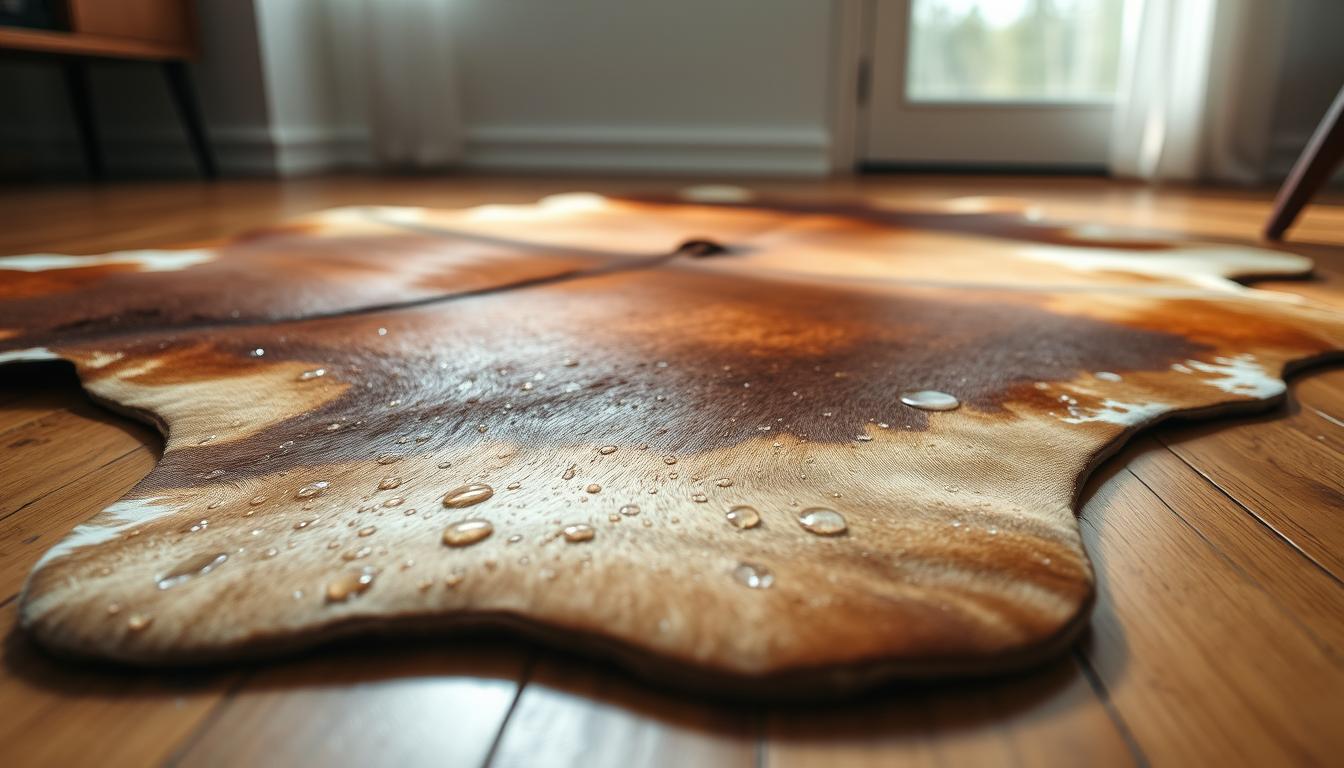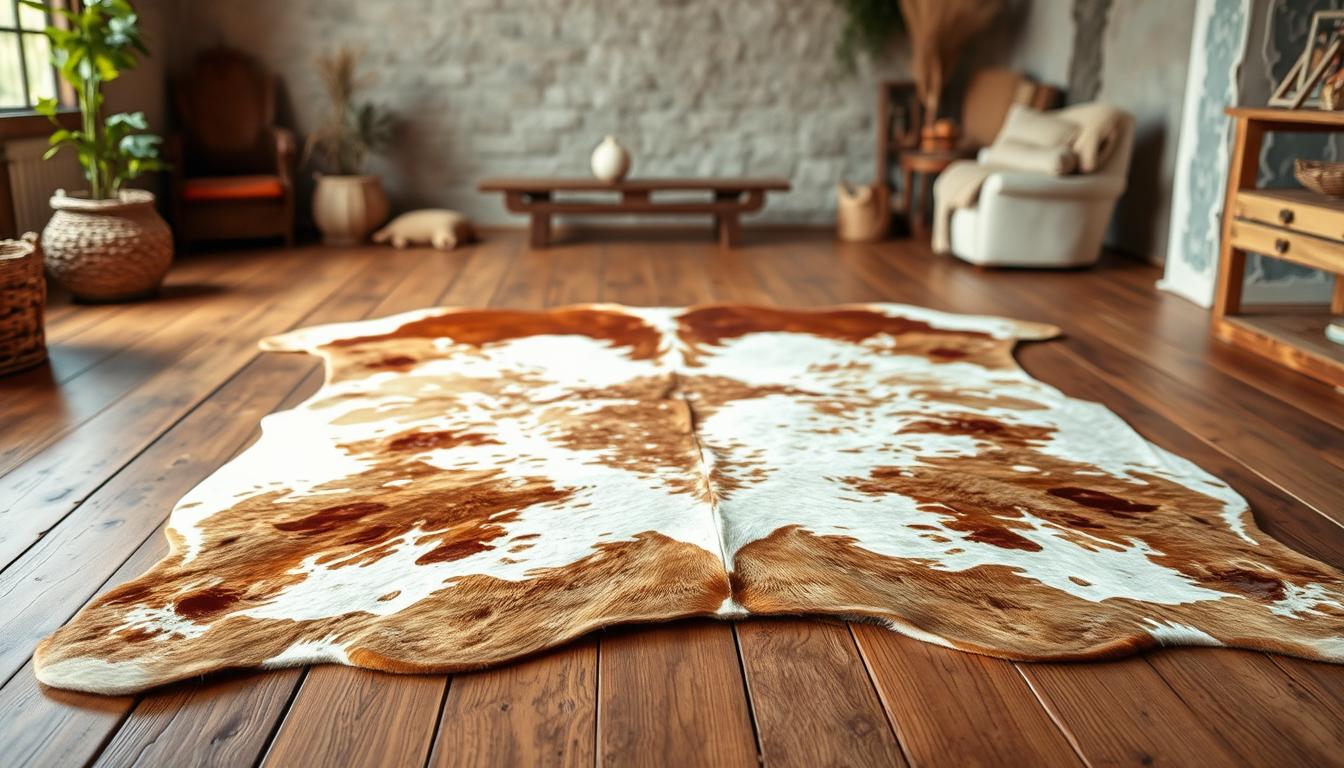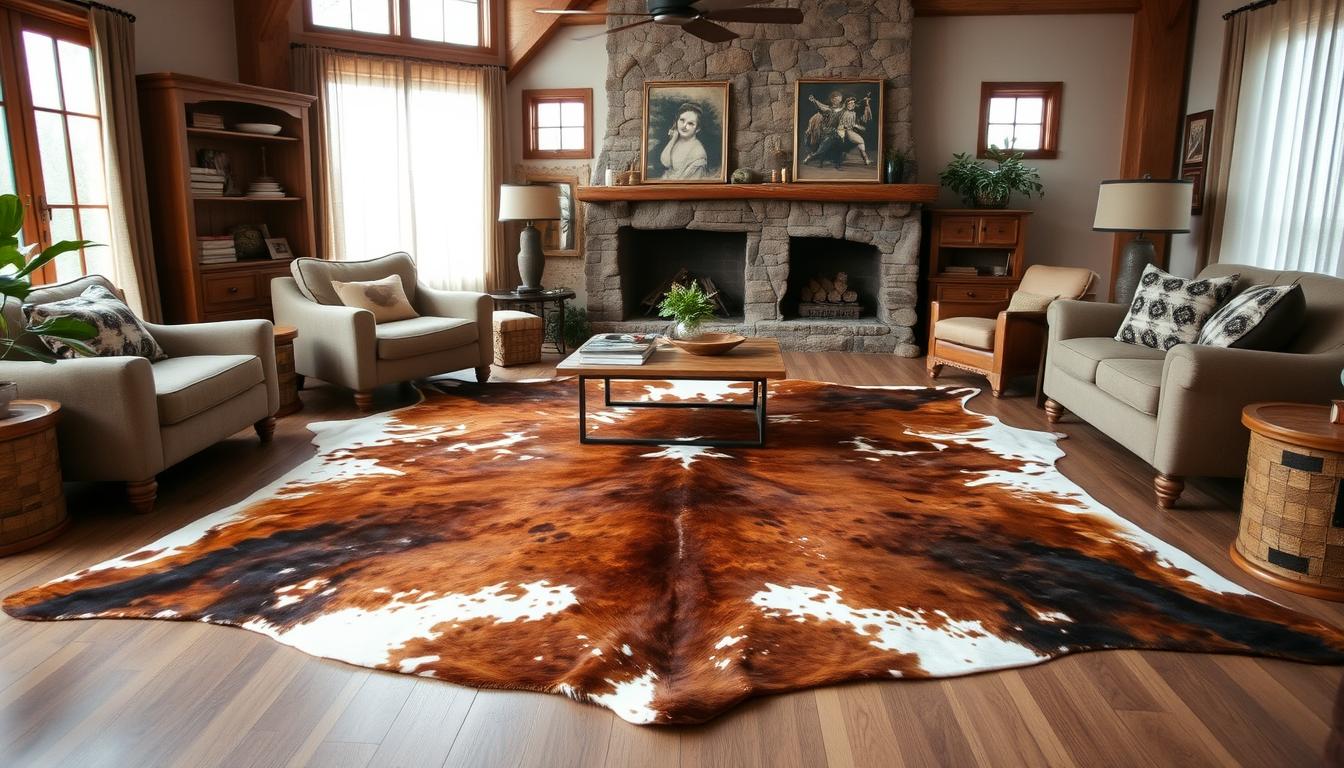
5 Truths About Cowhide Rugs Getting Wet

Natural materials like leather hides bring warmth to any space, but many homeowners hesitate to use them in moisture-prone areas. What most design enthusiasts don’t realize? These durable floor coverings possess hidden strengths—and vulnerabilities—that determine their lifespan.
Animal hides aren’t waterproof, but their built-in oils create a protective barrier against minor spills. A timely response to accidents prevents long-term damage, letting you enjoy their organic beauty without constant worry. However, prolonged exposure to humidity or standing liquid alters the material’s texture, leading to stiffness.
Understanding this balance is key to decorating confidently. Whether placed in living rooms or entryways, proper maintenance ensures your investment remains lush and supple for years. For deeper insights, explore our comprehensive FAQ guide addressing common concerns.
Key Takeaways
- Natural oils in animal hides offer temporary moisture resistance
- Quick spill cleanup prevents permanent texture changes
- Excessive water exposure leads to brittleness over time
- Strategic placement reduces long-term maintenance needs
- Regular gentle cleaning preserves the material’s integrity
Introduction to Cowhide Rugs
Transform your space with floor coverings that blend organic charm and lasting quality. Unlike mass-produced alternatives, these natural hide pieces tell a story through their distinctive markings and earthy tones.
What Makes These Natural Floor Coverings Unique
Every hide maintains its original shape and markings, creating functional art for your floors. The surface offers a luxurious feel underfoot—softer than wool yet more durable than synthetic fibers. Variations in hair length and density add depth to rooms, complementing modern and rustic designs alike.
| Feature | Natural Hide | Synthetic Rug |
|---|---|---|
| Pattern Uniqueness | 100% Original | Repeated Prints |
| Texture Complexity | Multi-layered | Flat Surface |
| Maintenance Needs | Low (Natural Oils) | High (Chemicals) |
Celebrating Organic Aesthetics
From speckled charcoal hues to creamy beige backgrounds, nature’s palette shines through. These pieces develop a richer patina over time, unlike dyed fabrics that fade. Their irregular edges and asymmetrical forms break up rigid room layouts, adding movement to your decor.
Discover how to showcase these statement pieces effectively in our comprehensive guide to natural hide floor. Learn placement strategies that highlight their best features while simplifying upkeep.
The Natural Beauty and Durability of Cowhide Rugs
Floor decor that withstands daily life while aging gracefully remains a homeowner’s holy grail. Natural hide floor coverings deliver both rugged resilience and evolving character, developing richer visual depth with each passing year.

These pieces thrive in active spaces where other materials falter. Their dense hair fibers and tightly woven collagen structure create built-in defense against scuffs and compression marks. Unlike flat-weave alternatives, textured surfaces disguise minor imperfections from shoes or furniture legs.
Busy entryways and family rooms benefit most from this toughness. Spills bead up temporarily on the hide’s oily surface, giving you precious minutes to blot accidents before penetration occurs. For persistent stains, our cleaning guide outlines safe removal techniques that preserve integrity.
Time enhances rather than diminishes these pieces. While synthetic options fray at edges or fade unevenly, natural variations in hair color deepen into sophisticated patinas. This organic aging process means your floor covering grows more distinctive – never dated.
Proper care ensures decades of service without sacrificing softness underfoot. Regular gentle brushing redistributes natural oils across the surface, maintaining supple flexibility that resists cracking. Rotate the piece seasonally to distribute wear patterns evenly across high-traffic zones.
can Cowhide rugs get wet
Accidental spills happen, but how you respond determines whether your floor covering thrives or deteriorates. Animal hides possess natural defenses, yet prolonged water contact requires strategic handling to maintain their luxurious texture.
Immediate Action for Wet Cowhide Rugs
Blot—don’t scrub—the affected area with an absorbent cloth immediately. Press firmly to lift moisture from the hair fibers without grinding particles into the hide. Rotate to a dry section of your cloth as it becomes saturated.
“Speed matters more than force when addressing spills,” notes a professional hide restorer. Let the piece dry flat in a well-ventilated space, flipping it periodically. Direct sunlight or heaters create uneven drying, leading to stiffness.
Long-term Care to Prevent Damage
While occasional mishaps won’t ruin quality pieces, repeated exposure weakens collagen bonds. Implement these practices:
- Check for residual dampness by pressing your palm against the hide
- Use breathable rug pads in humid rooms
- Schedule deep cleaning using methods from our specialized care guide
Mold spores develop within 48 hours on damp surfaces. Ensure complete dryness before reinstalling your floor covering. Properly maintained hides regain their supple feel, ready to handle life’s next adventure.
Proper Cleaning Methods and Maintenance Tips
Preserving your floor covering's beauty requires smart routines that work with its natural properties. Follow these proven strategies to maintain vibrant patterns and soft textures while preventing premature wear.
Vacuuming and Spot Cleaning Techniques
Use a vacuum with soft brush attachments to lift dirt without pulling hairs. Always move the nozzle in the direction of the hair growth – this prevents matting and keeps fibers aligned. For weekly upkeep, two passes across high-traffic zones remove surface debris effectively.

Address spills immediately with a microfiber cloth dampened in lukewarm water. Blot gently from the outer edge toward the center to contain stains. "Aggressive scrubbing flattens hairs permanently," warns professional cleaner Maria Torres. Let the area air-dry completely before resuming use.
Using Baking Soda and Mild Soap for Stain Removal
For stubborn marks, sprinkle baking soda lightly over affected areas. Let it sit for 15 minutes to absorb oils before vacuuming. Combine this with a solution of 1 tsp clear dish soap per cup of water for spot treatment.
Follow these steps for optimal results:
- Test cleaners on inconspicuous areas first
- Blot – never rub – during stain removal
- Brush dried areas with plastic bristles to restore texture
Regular maintenance using these methods keeps your investment looking fresh. Rotate the piece seasonally to ensure even wear patterns develop over time.
Addressing Common Stains and Spills on Cowhide Rugs
Life happens—coffee tumbles, pets explore, and sauces splatter. Your natural floor covering can handle these mishaps with the right approach. Immediate action paired with tailored techniques keeps patterns vibrant and textures intact.
Dealing with Liquid Spills and Drying
Blot spills within 30 seconds using microfiber cloths. For dried residues, gently scrape upward with a butter knife’s blunt edge. Mix 1 tbsp mild shampoo with 2 cups water to lift stubborn marks. Air-dry flat, rotating the piece every hour.
Managing Pet Accidents and Odor Control
Blot urine immediately, then apply a 1:2 vinegar-water solution. After drying, cover the area with baking soda for 24 hours. For persistent pet accident solutions, combine this method with enzymatic cleaners.
| Stain Type | Tools Needed | Time Sensitivity |
|---|---|---|
| Liquid Spills | Microfiber cloth, shampoo solution | 0-2 minutes |
| Food Grease | Eucalyptus oil, scraping tool | After drying |
| Pet Accidents | Vinegar mix, baking soda | Immediate + 24-hour treatment |
Grease stains vanish when dabbed with eucalyptus oil—its natural enzymes break down fats without harsh chemicals. Always test cleaners on hidden edges first. Remember: patience preserves your hide’s natural oils better than aggressive scrubbing.
Understanding Durability in High-Traffic Areas
High-traffic zones demand floor coverings that balance beauty with brawn. Natural hide pieces shine in active environments where synthetic materials falter, maintaining their structural integrity through daily use.
Wear and Tear Considerations for Busy Spaces
You’ll find these durable surfaces excel in entryways and hallways. Their dense hair fibers naturally resist matting, while the hide’s collagen structure bounces back from furniture impressions. Rotate your piece every six months to distribute foot traffic evenly across the surface.
Strategic placement enhances longevity. Avoid installing near exterior doors where outdoor elements threaten the material’s natural oils. For spaces receiving constant use, pair with breathable rug pads to prevent slippage and improve airflow.
Regular maintenance preserves suppleness in demanding areas. Gentle vacuuming removes abrasive particles before they grind into the hide. When cared for properly, these pieces develop character rather than showing premature aging—proof that practical elegance exists.
FAQ
How do you handle spills on cowhide rugs?
Blot spills immediately with a clean cloth, working from the edges toward the center. Avoid rubbing, as this can push moisture deeper. Let the rug air-dry flat, away from direct heat or sunlight to prevent cracking.
Are cowhide rugs suitable for homes with pets?
Yes! Their dense texture resists pet hair and minor scratches. For accidents, use mild soap and water on the affected area, followed by a baking soda sprinkle to neutralize odors. Regular vacuuming helps maintain their appearance.
Can baking soda remove stubborn stains?
Absolutely. Sprinkle baking soda on dried stains, let it sit for 15 minutes, then gently brush in the direction of the hair. Vacuum thoroughly to lift residue. For oily stains, mix dish soap with water and dab lightly before drying.
Do cowhide rugs fade in high-traffic areas?
While durable, excessive wear in busy spaces may cause gradual texture changes. Rotate the rug periodically to distribute foot traffic evenly. Use a soft-bristle brush to fluff flattened hairs and restore its natural look.
How do you enhance a room’s style with cowhide decor?
Cowhide rugs add a striking focal point with their organic patterns. Pair neutral tones with bold furniture or layer smaller hides for eclectic charm. Their versatility complements modern farmhouse, bohemian, and minimalist designs effortlessly.
What’s the best way to store cowhide rugs long-term?
Roll the rug with the hair facing outward and wrap it in breathable fabric. Store in a cool, dry place away from humidity. Avoid plastic covers, as they trap moisture and may lead to mildew.









